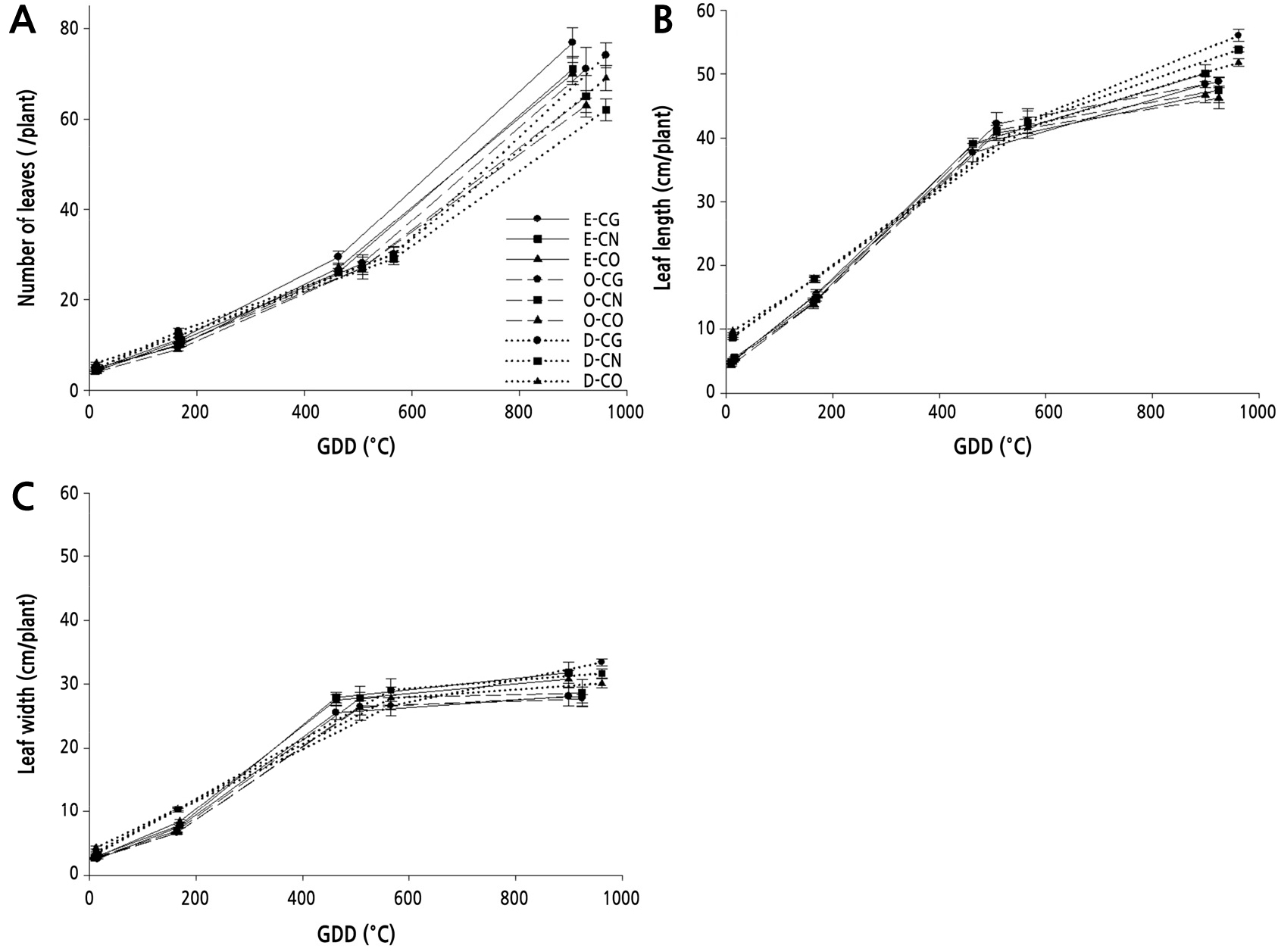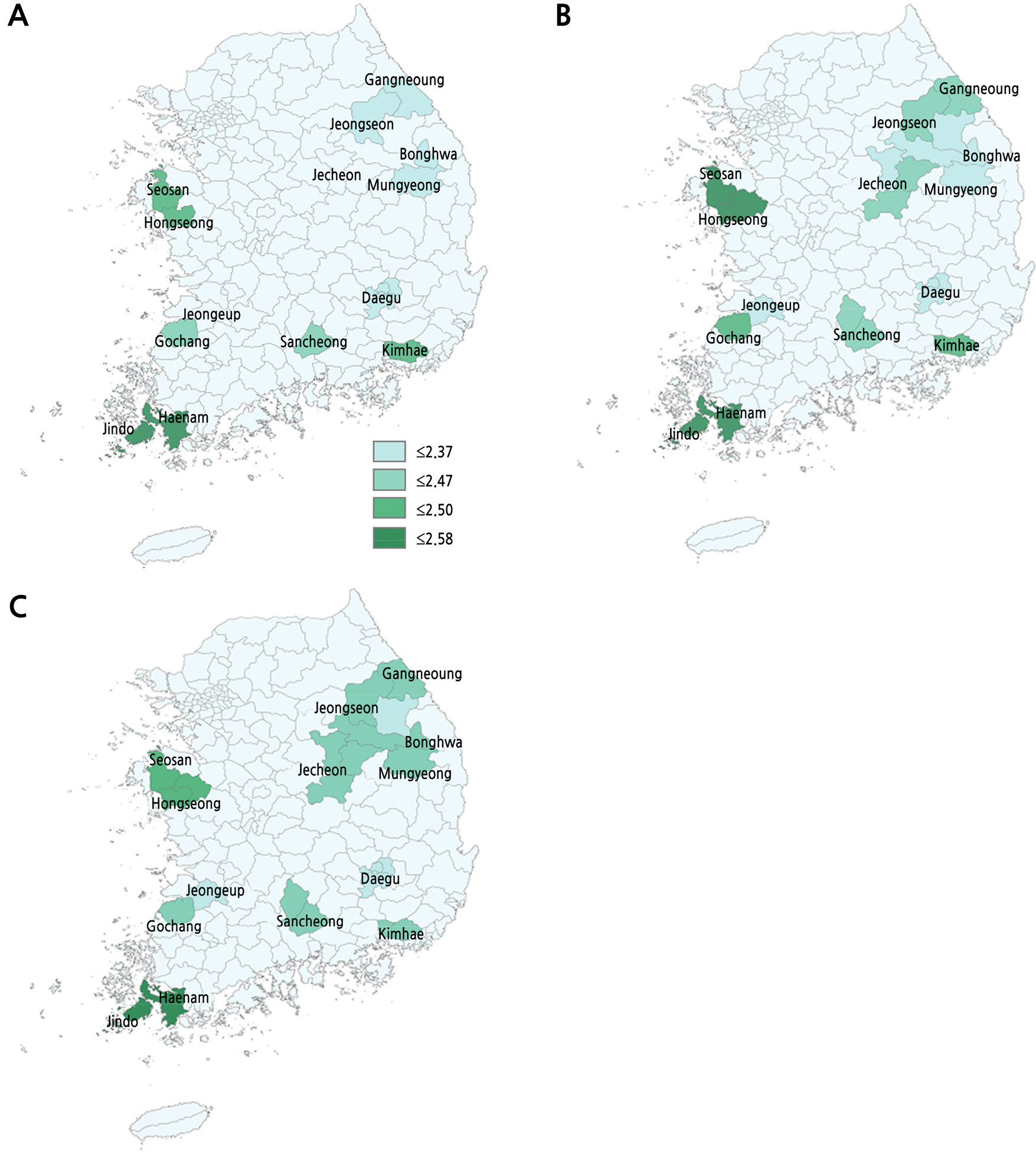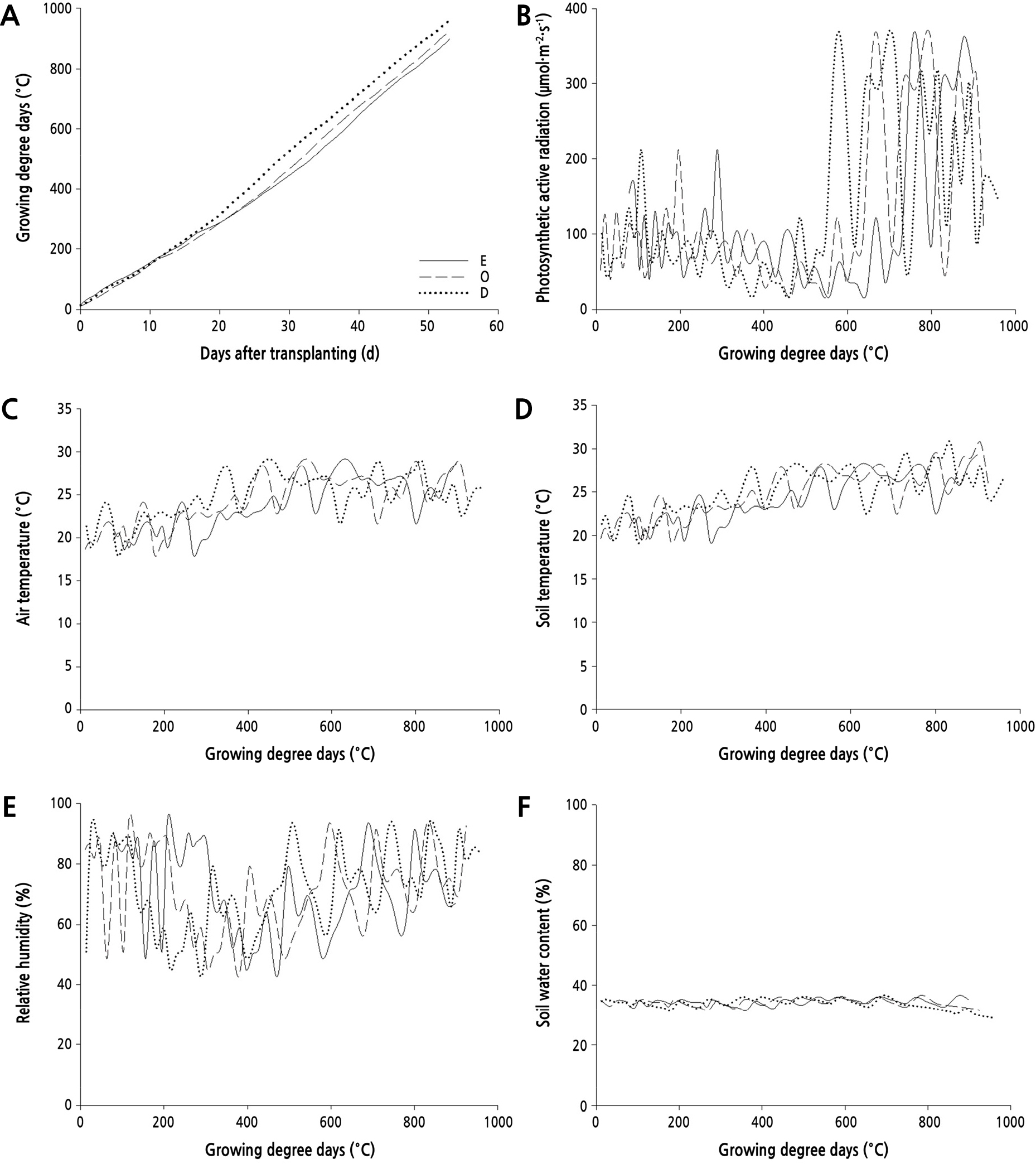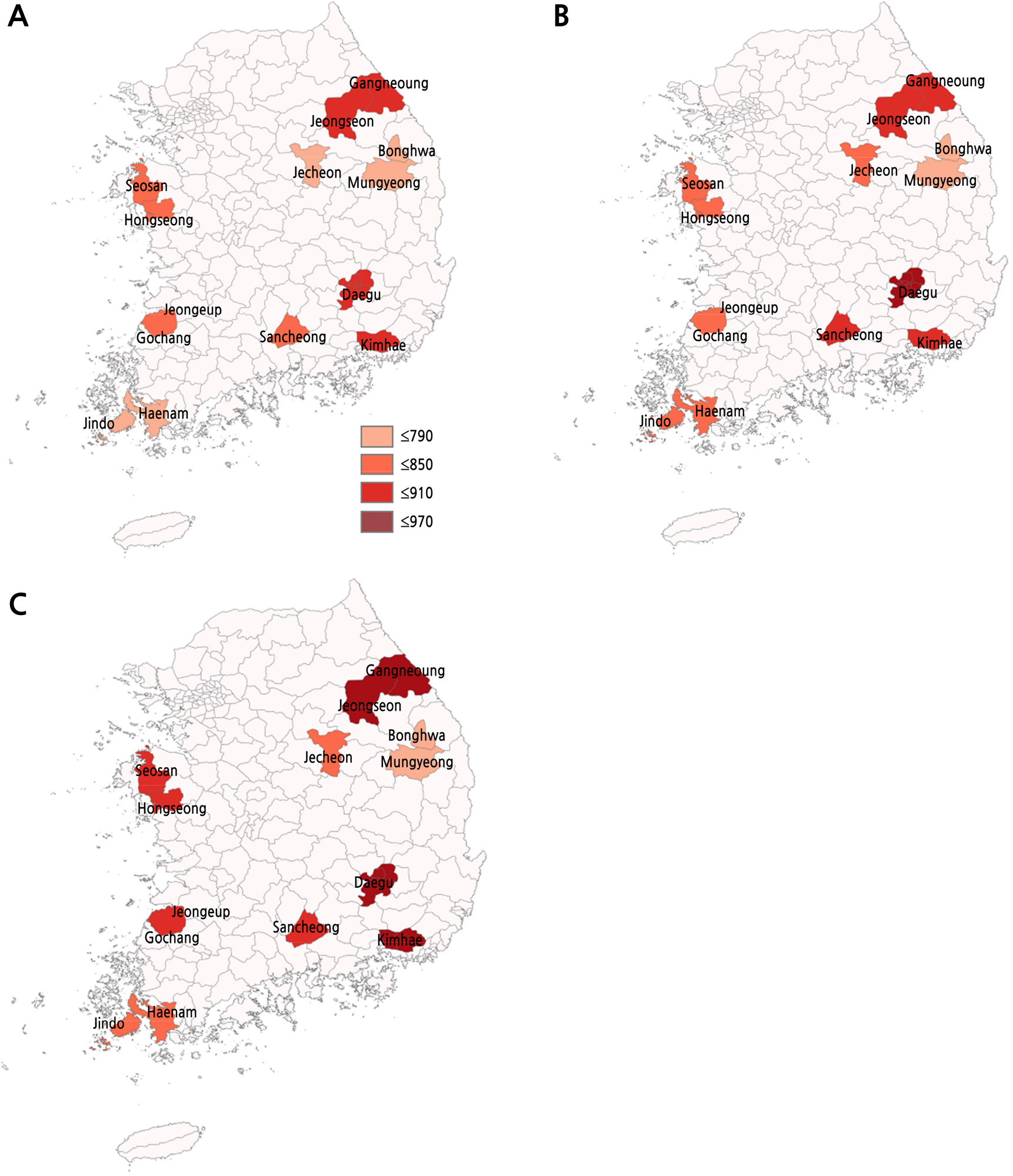Introduction
Materials and Methods
Plant Material
Measurement of GDDs and Shading Treatment
Measurement of Environmental Data
Measurement of Growth Parameters
Application of the Kimchi Cabbage Model
Data Analysis
Results and Discussion
Conclusion
Introduction
Kimchi cabbage (Brassica rapa L. ssp. Pekinensis), the main ingredient for Kimchi, is a widely consumed crop in Korea. Constant production of Kimchi cabbage is essential to meet the year-round consumption. The cultivation area of open-field Kimchi cabbage during the spring cultivation season in 2020 was approximately 2485 ha (KREI, 2020). Kimchi cabbage is a cool-season crop, and the optimal temperature for growth is 18-20°C. The appropriate temperature for head formation is 15-18°C, and the lowest temperature for growth is 4-5°C (Park et al., 2019). Kimchi cabbage is sensitive to temperature; they grow well at relatively high temperatures in the early growth stages until head formation. However, when head formation begins, the plants become susceptible to high temperatures, and soft rot (Oh et al., 2014) can occur, along with decreased growth (Son et al., 2015), production (Kim et al., 2015), and photosynthesis rate (Wi et al., 2020; Seo et al., 2021). Moreover, due to high temperature and frequent precipitation caused by abnormal climate conditions, calcium deficiency can occur, resulting in reduced value. Additionally, when Kimchi cabbage is exposed to high temperatures, core breakdown, tip burn, and decreased yields can occur (Hwang et al., 2003). Kimchi cabbage requires about eight hours of sunlight per day for head formation and is susceptible to drought, if the soil becomes dry in the early growth stages, decreased leaf development and yields will result (Park et al., 2019). It is important to be able to forecast the yield of Kimchi cabbage according to harvest time in different cropping types. The Kimchi cabbage model developed by Moon et al. (2019) is based on the growth process model concept such as photosynthesis, respiration, and growth. It can predict growth and yield using meteorological data regarding light, temperature, wind, precipitation, and humidity. Moon et al. (2019) developed a system for providing meteorological information for highland Kimchi cabbage cultivation areas in the summer using the model. The website offered detailed weather and crop growth information at the farm level (wds.agdcm.kr) and focused on predicting the yield of Kimchi cabbage in the summer harvest season for controlling product supply and price stabilization.
Growing degree days (GDD) is a measurement of daily temperature accumulation for predicting when a growth stage will occur, such as flowering and maturation. For example, GDD was used to estimate the yield of highland Kimchi cabbage (Kim et al., 2015), to predict the proper harvest time of Kimchi cabbage (Wi et al., 2018), and to estimate the growth and yields of peppers (Capsicum annuum L.) (Kim et al., 2018). Studies have been conducted to control the environment for reducing high temperature damages and physiological disorders in the open field and greenhouse. One method is to regulate radiation through shading. It has been reported that the growth of sedum (Sedum sarmentosum) (Lee et al., 2007), hooker chives (Allium hookeri) (Kim et al., 2017), and Cnidium officinale (Nam et al., 2020) under the shading conditions were greater than that under non-shading conditions in the open field. In addition, watermelon (Citrullus vulgaris) (Seong et al., 2014) and paprika (Capsicum annuum var. angulosum) (Ha et al., 2012) were grown in the greenhouse to avoid high temperatures in the summer. In Kimchi cabbage, shading improved head formation and controlled pests by lowering the temperature in the greenhouse (Park et al., 2019). However, there are few studies on shading in the cultivation of Kimchi cabbage.
The proper cultivation period has been predicted for Kimchi cabbage production during the spring cultivation. However, there are few studies on the best Kimchi cabbage cultivars or regional climates for spring cultivation and few studies using shading conditions. The experimental hypothesis was that the cultivation period differs for cultivars during the spring cultivation. Also, GDD is a crucial factor for determining the yields of Kimchi cabbage. This study’s objective was to determine optimal GDD and cultivars of Kimchi cabbage for growth and yield during spring cultivation under shading conditions. Additionally, Kimchi cabbage model was applied to the experimental area and the primary production regions during spring cultivation.
Materials and Methods
Plant Material
Three tested cultivars (‘Chungwang’, ‘Cheongna’, and ‘Cheongok’) of Kimchi cabbage (Brassica rapa L. ssp. pekinensis) were cultivated for this experiment. The seeds of ‘Chungwang’ were obtained from Sakata Korea Ltd. (Seoul, Korea); seeds of ‘Cheongna’ and ‘Cheongok’ were obtained from Woori Flower, Seed & Seedling Co. Ltd. (Gwacheon, Korea). The experiment was conducted from April 1 to July 6, 2020. The seeds were sown in a 105-plug tray filled with commercial soil (Numberone, Sanginmart, Daegu, Korea), three times at intervals of one week starting April 1, 2020. One-month-old healthy seedlings with 4-6 main leaves were selected and transplanted in a plastic-film greenhouse (6.4 m wide × 26.6 m long) at Kyungpook National University, located in Daegu, Korea (35°89'N, 128°61'E). Ridge width, furrow width, and distance between plants were 700, 400, and 500 mm, respectively.
Measurement of GDDs and Shading Treatment
GDD is a combination of daily maximum and minimum temperatures and base temperatures. Equation 1 is the formula for GDD (McMaster and Wilhelm, 1997). Tb equals 5°C (Park et al., 2019).
Where, Tmax is the daily maximum temperature, Tmin is the daily minimum temperature, and Tb is the base temperature.
The plants were transplanted three times at intervals of one week from May 1, 2020. Therefore, the three transplanting days were set as the treatment group with early, optimal, and delayed transplanting times. Also, the plants were harvested three times at intervals of one week beginning June 23, 2020. Between transplanting and harvesting, the GDD of early, optimal, and delayed transplanting times were 899, 924, and 961, respectively (Fig. 1A).
Shading was conducted with heat conservation covers that consisted of an aluminum screen, cotton, and nonwoven cloth (20 mm thin, shading ratio over 60%) to reduce the damage and physiological disorders caused by high temperature due to strong radiation, until June 14, 2020. The non-shading condition was performed for 9 d in the early transplanting time, 15 d in the optimal transplanting time, and 22 d in the delayed transplanting time. The non-shading condition was conducted when the GDD in early, optimal, and delayed transplanting were 729, 636, and 547, respectively. The photosynthetic active radiation (PAR) was measured using a spectrometer (LI-180, LI-COR, Inc., NE, USA) at plant height when the sun was shining inside the greenhouse. PAR under the shading conditions was 46 µmol·m-2·s-1, and 322.1 µmol·m-2·s-1 under the non-shading conditions.
Measurement of Environmental Data
The environmental data in the greenhouse, including PAR, air temperature (AT), relative humidity (RH), soil temperature (ST), and soil water content (SWC), were measured using a quantum sensor (LI-190R, Campbell Scientific, UT, USA), an air temperature and relative humidity sensor (HMP155, VISALA, FIN), and soil temperature and soil water content sensor (CS650, Campbell Scientific, UT, USA) and stored once a day in a data logger (CR1000, Campbell Scientific, UT, USA). The environmental data are shown in Fig. 1. The average PAR under shading was 81.7, and 224.7 µmol·m-2·s-1 for the non-shading conditions. It was confirmed that the shading ratio of heat conservation covers was about 60%. Total PAR of early, optimal, and delayed transplanting time was 5846, 6688, and 7368 µmol·m-2·s-1, respectively (Fig. 1B). The AT and ST ranged from 18.3 to 28.9°C and 19.5 to 30.8°C, respectively (Fig. 1C and 1D). The average AT in the greenhouse was about 1°C higher than the outside temperature under shading and about 2°C higher under the non-shading conditions. The RH and SWC ranged from 45.0 to 93.5% and 28.9 to 36.7%, respectively (Fig. 1E and 1F).
Measurement of Growth Parameters
Growth parameter measurements were conducted at transplanting, early growth (11 d after transplanting), leaf elongation (32 d after transplanting), and head formation (53 d after transplanting). The growth parameters, including the number of leaves, leaf length, and leaf width were evaluated at transplanting, and 11, 32, and 53 d after transplanting (DAT), respectively. Additionally, the growth parameters, such as shoot fresh weight, head height, head width, head weight, and head formation index, were measured at 53 DAT. The shoot fresh weight was measured by removing the underground part of the leaves. Equation 2 is the formula for the head formation index (Lee et al., 2008).
Measurements were performed by selecting five individuals for each cultivar for transplanting (n = 5). For measurement of 11, 32, and 53 DAT, an individual was selected from one cultivar in each experimental group, and the same individual was repeatedly measured (n = 5).
Application of the Kimchi Cabbage Model
The process-based model of Kimchi cabbage developed by Moon et al. (2019) was applied for growth and yield prediction using meteorological data regarding light, temperature, wind, precipitation, and humidity. The meteorological data included the daily maximum and minimum temperature, RH, precipitation, sunshine duration, and wind speed. The daily maximum and minimum temperature, and RH stored in the data logger were applied for the model. The precipitation, sunshine duration, and wind speed data were from the Daegu Meteorological Observatory (35°87'N, 128°65'E) provided by the Korea Meteorological Administration (KMA). During the spring cultivation, the 13 primary production regions of Kimchi cabbage were Gangneung, Jeongseon, Jecheon, Mungyeong, Bonghwa, Seosan, Hongseong, Jeongeup, Gochang, Haenam, Jindo, Sancheong, and Gimhae. The meteorological data used for these regions were provided by the KMA. The simulation of the Kimchi cabbage model was conducted using the Anaconda3 program (Anaconda, Inc.) based on the Python and R programming language (Moon et al., 2019). The shoot fresh weight of Kimchi cabbage was predicted for each GDD treatment at 53 DAT. The predicted shoot fresh weight of Kimchi cabbage in Daegu (the experimental region) and the primary production regions were compared by simulating the model. The sunshine duration in the primary production regions was considered by the shading ratio (60%) of heat conservation covers in order to be similar to the conditions in the experimental region. Assuming that shading conditions were conducted in each region, the sunshine duration was 40% of the actual value to induce the result under shading conditions. The GDD and predicted shoot fresh weight were compared by maps using the ArcGIS program (Eris, CA, USA).
Data Analysis
Experimental groups were a complementary randomized design with five plant per treatment. Statistical analysis was conducted using the SAS program (SAS 9.4, SAS Institute Inc., NC, USA). Significant differences were examined (p < 0.05) using two-way analysis of variance followed by Duncan’s multiple range test. Graphs were presented by SigmaPlot program (SigmaPlot 12.5, Systat Software Inc., CA, USA).
Results and Discussion
The number of leaves, leaf length, and leaf width during cultivation are represented in Fig. 2. The growth parameters were the highest in the delayed transplanting time. The growth parameters of ‘Cheongok’ at transplanting were the highest among the other cultivars, with six leaves, and the leaf length and width were 9.7 cm and 4.3 cm, respectively. The number of leaves and leaf length at 11 DAT was greater in ‘Chungwang’, at 13 and 17.9 cm, respectively, and the leaf width was greater in ‘Cheongna’, at 10.4 cm. The number of leaves and leaf length at 32 DAT was higher in ‘Chungwang’, 30 and 42.7 cm, respectively, and the leaf width was higher in ‘Cheongna’, at 29.1 cm. Thus, the number of leaves increased as the GDD increased, and the number of leaves increased dramatically from GDD 400 to 900. Previous reports have found that even at a cultivation temperature as high as 30°C, many leaves can be produced if the plants are irrigated sufficiently (Lee et al., 2015). However, leaf length and width increased in a sigmoid curve from GDD 180 to 600, showing that growth increased rapidly from 11 to 32 DAT.

Fig. 2.
The number of leaves, leaf length, and leaf width of kimchi cabbage (n = 5). A, number of leaves; B, leaf length; C, leaf width, E: Early transplanting time (GDD 899), O: Optimal transplanting time (GDD 924), D: Delayed transplanting time (GDD 961), CG: ‘Chungwang’, CN: ‘Cheongna’, CO: ‘Cheongok’.
Images of Kimchi cabbage at 53 DAT are shown in Fig. 3. The leaves in the delayed transplanting time showed tip burn disorders in ‘Cheongna (Fig. 3F)’ and ‘Cheongok (Fig. 3I)’. The investigation of inner number of leaves, head height, head width and head weight by destructing was conducted at head formation stage. The head formation index was low in the all GDDs and cultivars by high temperature, shading, and early investigation. At 53 DAT, the number of leaves was significantly different in the cultivars (Table 1). The cultivar with the highest number of leaves was ‘Chungwang’, and the number of leaves in the early, optimal, and the delayed transplanting was 77, 71, and 74, respectively. Most of the growth parameters were highest in the delayed transplanting time than in the others. In the delayed transplanting time, leaf length, leaf width, shoot fresh weight, head width, head weight, and head formation index of ‘Chungwang’ were highest. The leaf length, leaf width, and head width in the delayed transplanting time were 56.0, 33.4, and 21.8 cm, respectively. The shoot fresh weight and head weight in the delayed transplanting time were 3.2 and 1.1 kg, respectively. The head formation index in the delayed transplanting time was 4.0. In the study of Kimchi cabbage during spring cultivation, the head formation index was 11-13 (Lee et al., 2013), suggesting that the head formation index was low in our study. As the GDDs increased, the shoot fresh weight of ‘Chungwang’ increased. The head height of ‘Cheongna’ was the highest in the delayed transplanting, at 35.0 cm. The leaf length and shoot fresh weight did not differ among GDD or cultivars. The leaf width, head height, and head width significantly differed by GDD, but the head weight was not different in all treatments. The reason for the highest growth in the delayed transplanting time may be because the air temperature (AT) in the greenhouse was 1-2°C higher than the outside. It was reported that the early growth of fruits and vegetables was promoted due to the increase of soil temperature (ST) in tunnel cultivation, which significantly increased early yield (Moon et al., 2014). Growth was increased by tunnel cultivation in lettuce and winter cabbage (Lee et al., 2009).

Fig. 3.
Head of Kimchi cabbage at harvest (53 DAT). A, E-CG; B, O-CG; C, D-CG; D, E-CN; E, O-CN; F, D-CN; G, E-CO; H, O-CO; I, D-CO. E: Early transplanting time (GDD 899), O: Optimal transplanting time (GDD 924), D: Delayed transplanting time (GDD 961), CG: ‘Chungwang’, CN: ‘Cheongna’, CO: ‘Cheongok’. The red box (F and I) represent tipburn disorder of Kimchi cabbages leaves. The scale bar = 10 cm.
Table 1.
Growth and yield parameters of kimchi cabbage as affected by GDD and cultivars at 53 days after transplanting(n = 5)
| GDDz | Cultivar |
No. of leaves (/plant) |
Leaf length (cm/plant) |
Leaf width (cm/plant) |
Shoot plant weight (kg/plant) | Head | |||
|
height (cm/plant) |
width (cm/plant) |
weight (g/plant) |
formation index | ||||||
|
Early transplanting time | ‘Chungwang’ | 77 ay | 48.4 cd | 28.1 b | 2.3 bc | 26.9 b | 17.3 b | 690 a | 3.1 |
| ‘Cheongna’ | 71 abc | 50.1 cd | 31.8 ab | 2.1 bc | 28.3 b | 16.5 b | 786 a | 3.5 | |
| ‘Cheongok’ | 70 abc | 46.7 d | 30.8 ab | 1.9 c | 25.9 b | 17.7 b | 756 a | 3.5 | |
|
Optimal transplanting time | ‘Chungwang’ | 71 abc | 48.9 cd | 27.7 b | 2.4 bc | 33.6 a | 21.8 a | 889 a | 3.2 |
| ‘Cheongna’ | 65 bc | 47.5 d | 28.6 b | 1.9 bc | 32.0 a | 19.6 ab | 704 a | 2.7 | |
| ‘Cheongok’ | 63 c | 46.2 d | 28.1 b | 1.8 c | 32.7 a | 19.6 ab | 763 a | 2.9 | |
|
Delayed transplanting time | ‘Chungwang’ | 74 ab | 56.0 a | 33.4 a | 3.2 a | 34.3 a | 21.8 a | 1117 a | 4.0 |
| ‘Cheongna’ | 62 c | 53.8 ab | 31.7 ab | 2.6 ab | 35.0 a | 19.6 ab | 914 a | 3.3 | |
| ‘Cheongok’ | 69 abc | 51.8 bc | 30.1 ab | 2.5 abc | 32.4 a | 19.6 ab | 993 a | 3.8 | |
| Significancex | |||||||||
| GDD (A) | ns | ** | ** | ** | ** | ** | ns | ||
| Cultivar (B) | ** | * | ns | * | ns | ns | ns | ||
| A × B | ns | ns | ns | ns | ns | ns | ns | ||
Kimchi cabbage is a leafy vegetable so the fresh weight is affected by the number of leaves and leaf area (Son et al., 2015). The results obtained agreed with Sammis and Wu (1989); they reported that for the effect of the accumulation of GDD with DAT, the amount of growth increases when in the range of normal temperature for growth. Other reports showed that early growth was fast under higher than average temperature, and the fresh weight was high up to 50 DAT (Son et al., 2015). Other studies showed that as the light intensity and cultivation period increased, the fresh weight increased (Son et al., 2018). Our study agreed with that of other research that treatment groups with high temperature and sufficient irrigation had higher yields than those grown at an optimal temperature (Lee et al., 2015). Kim et al. (2015) reported that GDDs and head weight had a negative correlation, but our study showed that as GDDs increased, head weight increased. Kim et al. (2007) showed that shading was required in the greenhouse in highland Kimchi cabbage. When the plant factory temperature condition was 23°C, the growth rate of Pak choi was faster than that at 20°C. As a result, the number of leaves and fresh weight increased, and the yield improved which allowed for a reduction in the cultivation period (Choi et al., 2014). In this experiment, the increased growth is considered the effect of shading. This is also because the early harvest was performed before 70 DAT, which is the proper harvest time of Kimchi cabbage during spring cultivation.
Table 2 shows the results of predicted shoot fresh weight using the Kimchi cabbage model. At 53 DAT, the measured shoot fresh weight in the optimal transplanting time was 0.2 kg greater than the predicted value. Moreover, the measured shoot fresh weight of ‘Chungwang’, ‘Cheongna’, and ‘Cheongok’ in the delayed transplanting time was 1.1, 0.5, and 0.4 kg higher than the predicted values, respectively. However, the predicted shoot fresh weight in Daegu was 2.4, 2.4, and 2.3 kg in early, optimal, and delayed transplanting time, respectively. Although the shading rate was as high as 60%, it was considered to have effect because it resulted in a higher measured shoot fresh weight than predicted using the Kimchi cabbage model.
Table 2.
Comparison of measured and predicted shoot fresh weight of Kimchi cabbage as affected by GDD and cultivars
| Cultivar | GDDz 899 | GDD 924 | GDD 961 | ||||||
|
Predicted value (kg) |
Measured value (kg) |
RMSE (kg) |
Predicted value (kg) |
Measured value (kg) |
RMSE (kg) |
Predicted value (kg) |
Measured value (kg) |
RMSE (kg) | |
| ‘Chungwang’ | 2.3 | 2.3 | 0.008 | 2.2 | 2.4 | 0.34 | 2.1 | 3.2 | 0.28 |
| ‘Cheongna’ | 2.3 | 2.1 | 0.13 | 2.2 | 1.9 | 0.72 | 2.1 | 2.6 | 0.13 |
| ‘Cheongok’ | 2.3 | 1.9 | 0.30 | 2.2 | 1.8 | 0.77 | 2.1 | 2.5 | 0.19 |
The GDDs in the primary production regions during the spring cultivation season are shown in Fig. 4. The region with the highest GDD was ‘Gimhae’ in the early, optimal and delayed transplanting times, which was 876, 903, and 931, respectively. However, the region with the lowest GDD was Bonghwa in the early, optimal, and delayed transplanting time, which was 704, 724, and 762, respectively. Additionally, we compared the shoot fresh weight of each region by simulation of the Kimchi cabbage model (Fig. 5). The highest predicted regions were Jindo, Haenam, and Seosan with about 2.6 kg in all transplanting times. Therefore, the range of GDD in the primary Kimchi cabbage production regions during spring cultivation was 750-870 for the optimal cultivation time. The limitation of the Kimchi cabbage model developed by Moon et al. (2019) was that it used meteorological data unrelated to greenhouse cultivation such as wind speed and precipitation. Therefore, it is considered that the model needs to be supplemented with meteorological data suitable for greenhouse cultivation. The actual shoot fresh weight data were measured only twice, which limited to comparison with the predicted shoot fresh weight. Thus, the model’s accuracy could be improved if more data on shoot fresh weight are obtained.

Fig. 5.
The shoot fresh weight predicted using the Kimchi cabbage model developed by Moon et al. (2019) in the primary production regions during the spring cultivation season by different transplanting dates. A, early transplanting time; B, optimal transplanting time; C, delayed transplanting time.
The delayed transplanting time resulted in the highest values for most of the growth parameters. However, tip burn disorders occurred in ‘Cheongna’ and ‘Cheongok’ in the delayed transplanting time (Fig. 3F and 3I). Therefore, though the delayed transplanting time gave the highest growth, considering the physiological disorders, we decided that the optimal harvest time was GDD at 924 under shading. The number of leaves is important for head formation, and the number of leaves was higher in ‘Chungwang’ in all transplanting times. Furthermore, the number of leaves in ‘Chungwang’ was greater than in the other cultivars in all transplanting times. Therefore, we considered that ‘Chungwang’ grown during spring cultivation under shading was less sensitive to high temperature than the other cultivars. The range of GDD in the primary Kimchi cabbage production regions during the spring cultivation season was 750-870 for the optimal harvest time. This indicated that if shading is conducted even in areas with relatively high temperatures, such as Daegu or in the primary production regions, physiological disorders caused by temperature or rain will be reduced, and high quality and stable production will be possible even if the GDD is high. Our results indicated that shading improved Kimchi cabbage growth in inadequate environments such as high temperature during the spring cultivation season.
Conclusion
Our results indicated that ‘Chungwang’ was less sensitive to high temperature stresses than the other cultivars during spring cultivation. GDD 924 was the optimal cultivation time under shading conditions in Daegu. GDD 750-870 is considered the appropriate harvest time in the primary production regions during spring cultivation. If shading is performed in these regions, a constant production could be possible, reducing damage from high temperature. In addition, Kimchi cabbage’s growers can know with GDD corresponding to the optimal cultivation time the sowing and transplanting times for each cultivation regions. In addition, it was possible to predict the yield through the Kimchi cabbage model. Results indicated that a grower’s decision support for practical cultivation and a distributor predict yield and harvest timing in spring cultivation.




